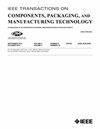IF 2.3
3区 工程技术
Q2 ENGINEERING, ELECTRICAL & ELECTRONIC
IEEE Transactions on Components, Packaging and Manufacturing Technology
Pub Date : 2025-01-17
DOI:10.1109/TCPMT.2025.3531127
引用次数: 0
摘要
本文针对碳化硅(SiC)功率模块中的大面积银烧结接头提出了一种替代工艺方法,并集成了干燥工艺。该方法大大简化了大面积烧结的生产工艺。作为一个典型应用,使用该方法封装了碳化硅功率模块(1200 V/17 m $\Omega $,八个芯片并联),实现了陶瓷基板(50/times 60$ mm2)和散热器之间的可靠连接。通过对机械性能、热阻和热冲击可靠性的评估,验证了所提出的大面积银烧结法的优势。结果表明,调整银浆印刷厚度可以适应活性金属钎焊(AMB)基板的翘曲。优化干燥温度和加热速率可以获得结构均匀、致密的大面积烧结银层,即使采用单一印刷和集成干燥工艺也是如此。烧结接头的孔隙率为 2%-3%,没有明显的分层缺陷。与传统焊料 SnSb5 相比,银烧结连接层的平均剪切强度提高了 95%。在热冲击条件下($- 60~^{\circ }$ C 至 $+ 150~^{\circ }$ C),银烧结层表现出卓越的可靠性,1000 次循环后,连接层仅有 2% 的降解。此外,与传统焊料(SnSb5)相比,功率模块的总热阻降低了 10.3%,有效提高了碳化硅模块的散热能力。总之,这项研究发现并解决了大面积烧结中的关键工艺问题,为封装高功率密度和高可靠性的 SiC 模块提供了重要指导。本文章由计算机程序翻译,如有差异,请以英文原文为准。
Research on the Key Processes of Large-Area Silver Sintering for SiC Power Modules
In this article, an alternative process method was proposed for the large-area silver sintering joint in silicon carbide (SiC) power modules, with integrated drying process. This proposed method significantly simplified the production process of large-area sintering. As a typical application, SiC power modules (1200 V/17 m $\Omega $ , eight chips in parallel) were packaged using the method, achieving a reliable connection between ceramic substrates ( $50\times 60$ mm2) and heat sinks. The advantages of the proposed large-area silver sintering have been verified through the assessments of mechanical properties, thermal resistance, and thermal shock reliability. Results indicate that adjusting the silver paste printing thickness can accommodate the warpage of active metal brazing (AMB) substrates. Optimizing the drying temperature and heating rate allows for a structurally uniform and dense large-area sintered silver layer, even with single printing and integrated drying processes. The sintered joint has a porosity of 2%–3%, with no apparent delamination defects. Compared to traditional solder SnSb5, the average shear strength of the silver sintering connection layer has increased by 95%. Under thermal shock conditions ( $- 60~^{\circ }$ C to $+ 150~^{\circ }$ C), the silver sintering layer demonstrates excellent reliability, with only a 2% degradation of the connection layer after 1000 cycles. Furthermore, compared to traditional solder (SnSb5), the total thermal resistance of power modules is reduced by 10.3%, effectively enhancing the heat dissipation capacity of the SiC module. In summary, this study identified and resolved key process issues in large-area sintering, providing significant guidance for the packaging of high-power density and high-reliability SiC modules.
求助全文
通过发布文献求助,成功后即可免费获取论文全文。
去求助
来源期刊

IEEE Transactions on Components, Packaging and Manufacturing Technology
ENGINEERING, MANUFACTURING-ENGINEERING, ELECTRICAL & ELECTRONIC
CiteScore
4.70
自引率
13.60%
发文量
203
审稿时长
3 months
期刊介绍:
IEEE Transactions on Components, Packaging, and Manufacturing Technology publishes research and application articles on modeling, design, building blocks, technical infrastructure, and analysis underpinning electronic, photonic and MEMS packaging, in addition to new developments in passive components, electrical contacts and connectors, thermal management, and device reliability; as well as the manufacture of electronics parts and assemblies, with broad coverage of design, factory modeling, assembly methods, quality, product robustness, and design-for-environment.
 求助内容:
求助内容: 应助结果提醒方式:
应助结果提醒方式:


